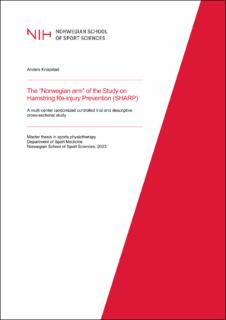| dc.description.abstract | Introduction: Hamstring injury (HI) is the most common injury in football and has the highest re-injury incidence. The nordic hamstring exercise (NHE) has shown to reduce the incidence of HIs in football players. The research on prevention of hamstring re-injuries is very limited. This master thesis was a contribution to the SHARP study, investigating the effect of the NHE in preventing hamstring re-injury in football players. Football players are known for having low adherence to the NHE. For injury prevention programs to work, it is important to understand the attitudes and beliefs of Norwegian pysiotherapists (PTs) on the NHE an protocol.
Method: This master thesis was part of an international multi-centre randomized controlled trial, the SHARP study. Players were allocated to either an intervention group (IG, NHE protocol) or a control group (CG, continued routine training). The primary outcome was the number of early hamstring re-injuries. Secondary outcomes were NHE adherence and training/match exposure. A descriptive cross-sectional pilot study was also conducted within the “Norwegian arm” study where a questionnaire was sent to Norwegian PTs to gain insight in their attitudes and beliefs on the NHE.
Results: Zero players were recruited from the “Norwegian arm” to the main SHARP study. Tweenty-seven players were recruited to the main SHARP from collaborationg institutes, eight were included to the “Norwegian arm”. Zero hamstring re-injuries were found in IG and CG. The adherence to the NHE protocol (IG) was low (45%). Twentysix PTs responded to the questionnaire. Results indicate that Norwegian PTs recognize the importance of hamstring prevention, with the NHE being well adopted and valued. One third of the PTs reported “sessions per week” and “reps per set/training” being “too high” in the prescribed NHE protocol used in the main SHARP study.
Conclusion: An insufficient sample size, including players of both genders at different ages and competitive levels was recruited, therefore no conculsion could be made on the short- and long-term effect of the NHE in preventing hamstring re-injuries. Future research should focus on optimizing the player recruitment process and to further investigate the attitude and beliefs of players and coaches to better understand potential barriers to the low study participation and adherence to the NHE. | en_US |
